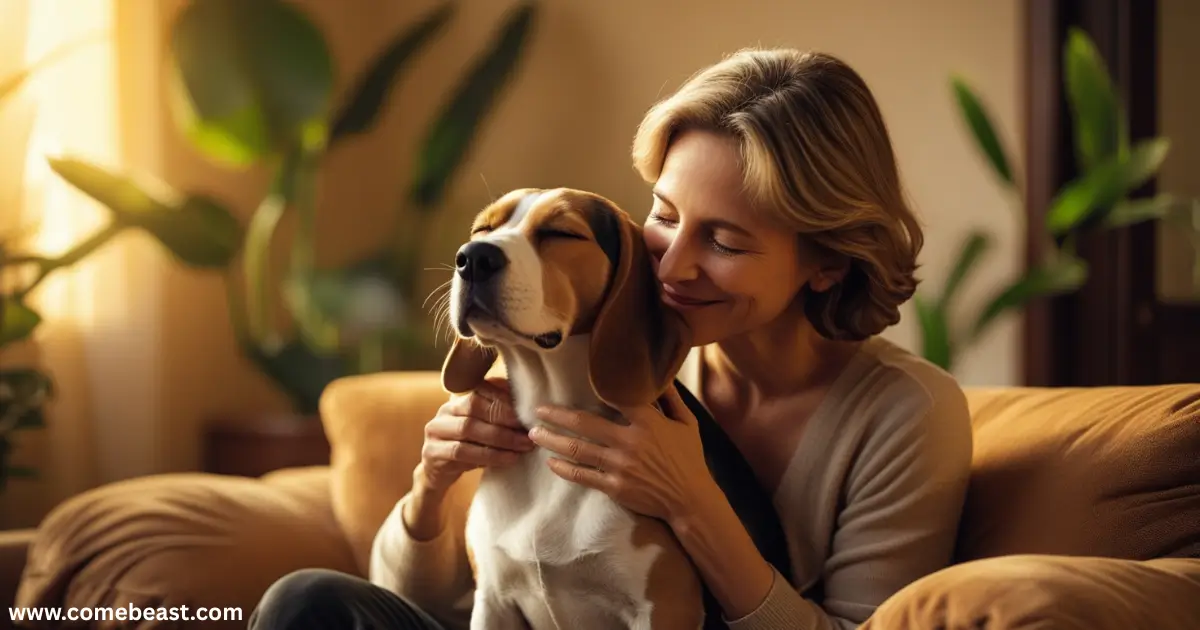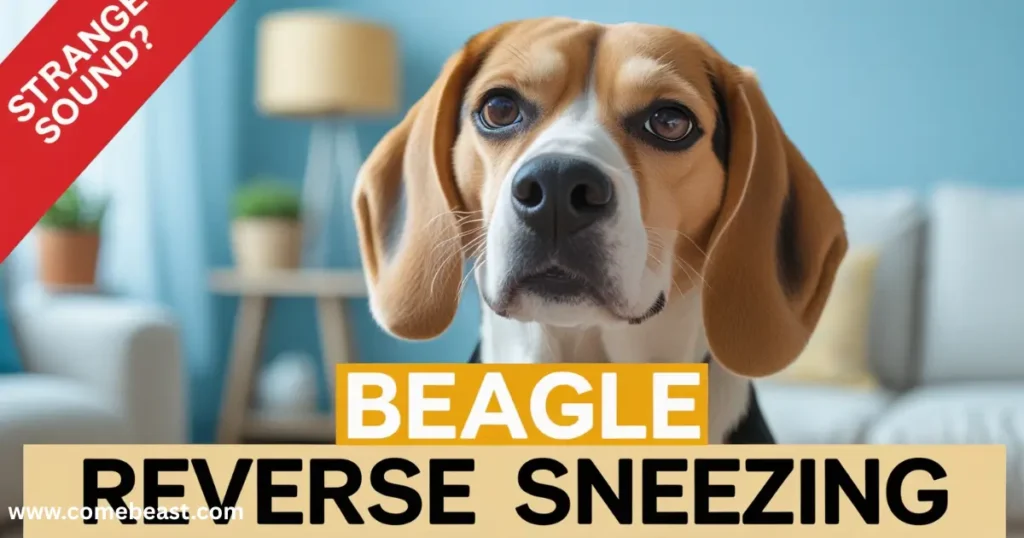Understanding Reverse Sneezing in Beagles
The strong snorting sounds which characterize Beagle reverse sneezing act as a normal occurrence. The condition produces a worrisome sound which turns out not to cause any damage. Most beagle owners experience alarming feelings the moment they hear their pet make this unusual sound. During this sneeze the dog pulls breathing air into his body. The condition develops quickly after which it naturally terminates itself. The condition is frequent among beagles and other dogs with similar sizes. The typical safe but alarming health condition of Beagles appears as severe as it sounds. Knowledge about the nature of reverse sneezing helps calm down feelings of panic.
Commonness of Reverse Sneezing in Beagles
Beagle reverse sneezing appears frequently in this breed of dogs. Airway blockages occur easily because of the beagle’s small nose as well as throat structure. They also sniff a lot. Their attraction to smells results in the entry of dust along with dirt and pollen into their bodies. That sets off reverse sneezing. Reverse sneezing occurs frequently among Beagles above all other canine breeds. The long soft palate structure in Beagles causes air blockage by flapping against their airway. The blocking elements in the beagle throat initiate the reverse sneeze response.

How Reverse Sneezing Sounds in Beagles
When Beagle dogs reverse sneeze they produce a loud snorting sound. The sound can produce the effects of being unable to breathe or the feeling of choking. The noise is sharp and quick. A beagle stands motionless with its elbows extended wide. Beagles extend their heads while their necks become tense. The mouth stays closed. A reverse sneeze diagnosis is confirmed by all of the presented signs. Reverse sneezes have an intimidating appearance without inflicting any pain to the dog.
Why Beagle Reverse Sneezing Gets Worse
Different factors exist that can initiate an episode. The types of triggers which cause sneezes become easier to prevent through awareness of these triggers. Some triggers come from inside. The surrounding air of your beagle becomes the source of some triggers that cause this reaction. Most episodes follow a specific consistent pattern. Below are the top reasons.
Environmental Irritants and Allergens
This condition begins when they inhale elements such as dust, pollen, and smoke. Due to their short nasal tube, the beagle inhales a high amount of dust from the ground level. Air fresheners together with perfumes and strong scents function as common triggers for these occurrences. The same effect occurs when using cleaning sprays or powders as irritants. Montreal beagles experience fewer sneezing episodes when their environment remains air clean.

Excitement and Sudden Movement
Beagles love to play. Beagles tend to reverse sneeze following moments of sudden happiness. The onset of reverse sneezing commonly occurs when you welcome home from work. Exercise in the yard can result in this condition as well. Rapid breathing together with quick sniffing movements cause the palatal tissues to dance. That sets off the sneeze.

Leash Pressure on the Neck
A constricted collar during leash use might cause this issue. Air flow becomes restricted when throat compression occurs because of the collar. When air reaches the soft palate, the sneezing process initiates. Try a harness instead. The physical force undergoes uniform distribution in the chest area. That keeps the neck safe.

Is Beagle Reverse Sneezing Dangerous?
Reverse sneezing episodes in Beagles do not create harm to the dog. It just sounds scary. Your dog can still breathe. The sneeze episode ends naturally within a matter of seconds. The airway remains open during an occurrence of reverse sneezing. There is no need to give your dog any medicine during these episodes. The vet needs to examine your beagle when these episodes are prolonged or occur very frequently. When caring for this condition, it is best for you to remain emotionally stable.
How Long Does Reverse Sneezing Last in Beagles?
Beagle reverse sneezes normally continue between two to sixty seconds. Most sneezes stop fast. After several snorts the condition returns to normal. A veterinarian should examine your Beagle after reverse sneezing has lasted longer than two minutes. The duration of prolonged sneezes should serve as a cue to visit a veterinarian.
Are Beagles Hound Dogs? :10 Shocking Truths
Beagle Reverse Sneezing vs. Regular Sneezing
Sneezes under normal conditions propel air forward from the body. Reverse sneezing pulls air in. The sound is the main clue. Regular sneezes usually last only around one or two brief incidents, but reverse sneezes extend beyond normal sneeze duration. When a beagle experiences a reverse sneeze, the event will stretch longer and produce multiple throat sounds. The characteristic behavior involves both large recordings of air and neck extension throughout the episode.
Treating Reverse Sneezing in Beagles
Rub the throat softly. This calms the airway. Breathe softly towards your Beagle’s face to assist the sneeze. That makes them swallow. Swallowing stops the sneeze reflex. Lightly pressing the nose for one short second makes a difference in treatment. The rest of the air passes through their mouth because of this condition. The episode becomes shorter when someone provides assistance during it.

What Not to Do When Your Beagle Reverse Sneezes
Do not panic. The key to preventing your dog’s anxiety is remaining composed. Do not shake or hit the dog. That can make it worse. Inserting fingers into the mouth after a sneeze episode should be avoided. Your beagle is not choking. The administration of medication to your dog should always start with consulting a veterinary professional. The typical episode concludes naturally.
When to See a Vet for Beagle Reverse Sneezing
A veterinary check is necessary if your beagle sneezes continuously each day. Veterinary consultation becomes necessary whenever a reverse sneezing episode continues past two minutes. Pay immediate attention to your beagle’s case if they exhibit both coughing along with breathing difficulties. Blood loss from the nose combined with loss of breath requires an immediate visit to the vet. Medical issues should be considered when an affected beagle experiences a change in reverse sneezing patterns.
Are Beagles Hypoallergenic Dogs? 10 Shocking Facts Inside
Is Reverse Sneezing Common in All Beagles?
This condition occurs within most of the beagle population. Some do it once a week. Some only once a month. Beagles start having this condition at an early stage during their puppyhood. Some grow out of it. Beagles develop this behavior either temporarily before getting older or continue with it until the end of their life. The beagle breed has this condition as one of its most frequently occurring features.
Reverse Sneezing in Beagle Puppies
Young beagle dogs sneeze in reverse with higher frequency than their adult counterparts. Their airways are still growing. Reverse sneezing happens more frequently among active snifflers in the beagle breed. Reverse sneezing occurs more frequently because of their physical attributes. The intermittent sneezes known as reverse sneezing occur normally in puppy beagles. In case reverse sneezing seems severe consult your veterinarian for examination.
Beagle Health Conditions Linked to Reverse Sneezing
Several medical conditions can establish a link between health problems and worsened reverse sneezing cases. Death of the trachea or nasal mites along with polyps and tracheal weakness can result in worse reverse sneezing occurrences. All these press on the airway. That triggers more sneezing. Seek medical attention from your vet for your beagle when they reverse sneeze along with other indicators such as wheezing and feel fatigued. Early care is best.
Beagle Kennel Cough vs Reverse Sneezing
The medical condition known as reverse sneezing does not qualify as a disease. Kennel cough is. Kennel cough induces the dog to produce dry hacking sounds. The snorting sound of reverse sneezing is typical for the condition. The coughing condition of kennel cough lasts longer than regular reverse sneezing and also easily spreads from dog to dog. This condition does not. Apply helpful observation skills to know what separates these two events from each other.
Vet Diagnosis for Beagle Reverse Sneezing
Vets will ask questions. They check the nose and throat. The examination process might require a scope to conduct comprehensive checks. The healthcare professional will perform tests to identify allergies or mites when they diagnose the condition. Professional vet evaluation enables the elimination of more severe underlying medical problems. However, this issue poses no health risks to dogs as long as it does not require medical help.
Treatment Options for Beagle Reverse Sneezing
The condition usually requires no medical intervention. The treatment of choice for allergic causes involves administering antihistamines. A veterinarian will prescribe medication when mites are detected during veterinary examination. Nasal sprays might be necessary for certain dogs as treatment. For the majority of beagles daily care is not necessary to address reverse sneezing events. Knowledge about what to do for your beagle usually proves adequate in most circumstances.
Can You Stop Beagle Reverse Sneezing?
There are steps you can take to reduce the occurrence of sneezing in your Beagle. Keep your home free of dust. Use a harness, not a collar. Strong odors should avoid getting into the nose of your dog. During dust pollen season keep all windows tightly closed in your home. Wash dog beds often. These steps all help. The neutering process does not guarantee that your beagle will avoid sneezing attacks.
Natural Remedies for Beagle Reverse Sneezing
Due to low risk, start with little amounts of honey. It soothes the throat. Combining the use of humidifiers with proper air moisture helps reduce sneezing incidents. The moistened airpath remains open because of these interventions. Some dog owners treat their dogs with coconut oil to improve their breathing capacity. Before giving any remedy, consult your veterinarian. Proper treatment of this condition requires cautious methods.
FAQ Section
Beagle Reverse Sneezing and Breathing Issues
This condition does not create any blockage in the airways. Your dog can still breathe. Several warning signs exist even though reverse sneezing does not block airways and appears distressing. The sneeze stops fast. Contact your vet right away if your dog faces breathing issues after the sneeze episode. Reverse sneezes in Beagles are harmless, though they need proper identification from asthma or choking symptoms.
What frequency of beagle reverse sneezing is too frequent?
You should consult with your veterinarian when your beagle experiences daily episodes or more. Regular occurrences should not exceed a few times within a month. The occurrence of regular sneezes with no end could indicate allergies or medical conditions. Make regular records of sneezing frequency. Such tracking data will assist veterinarians in identifying the underlying cause. Reverse sneezing episodes in beagles need to stop only occasionally.
Do Beagles Outgrow Reverse Sneezing?
Certain beagles develop out of the tendency to reverse sneeze as they mature. The condition persists throughout their life span for some individual dogs. Newly born beagles tend to sneeze at higher rates since they remain actively engaged in discovery. Adult beagles tend to reduce reverse sneezing only when their trigger factors disappear. But it may never stop fully. The symptoms of reverse sneezing in Beagles usually maintain a light intensity throughout their lifetime.
Is Beagle Reverse Sneezing Permanent?
No, you cannot stop it fully. Lowering the number of occurrences stands as your only means of control. The three major factors that reduce reverse sneezing in beagles consist of clean air and minimal perfume use alongside harness implementation. The sneezing behavior of your beagle will probably continue even in the future. But it does not harm them. Reverse sneezing in beagles belongs to the category of the most secure doggy behaviors.








[…] Beagle Reverse Sneezing: 8 Powerful Insights […]
[…] Beagle Reverse Sneezing: 8 Powerful Insights […]
[…] social characteristics of beagles drive them to find happiness in interacting with human friends alongside other dogs. Beagles remain […]
Great read! I never realized how common reverse sneezing is in Beagles. Your explanation and advice have put my mind at ease. Appreciate the insights!